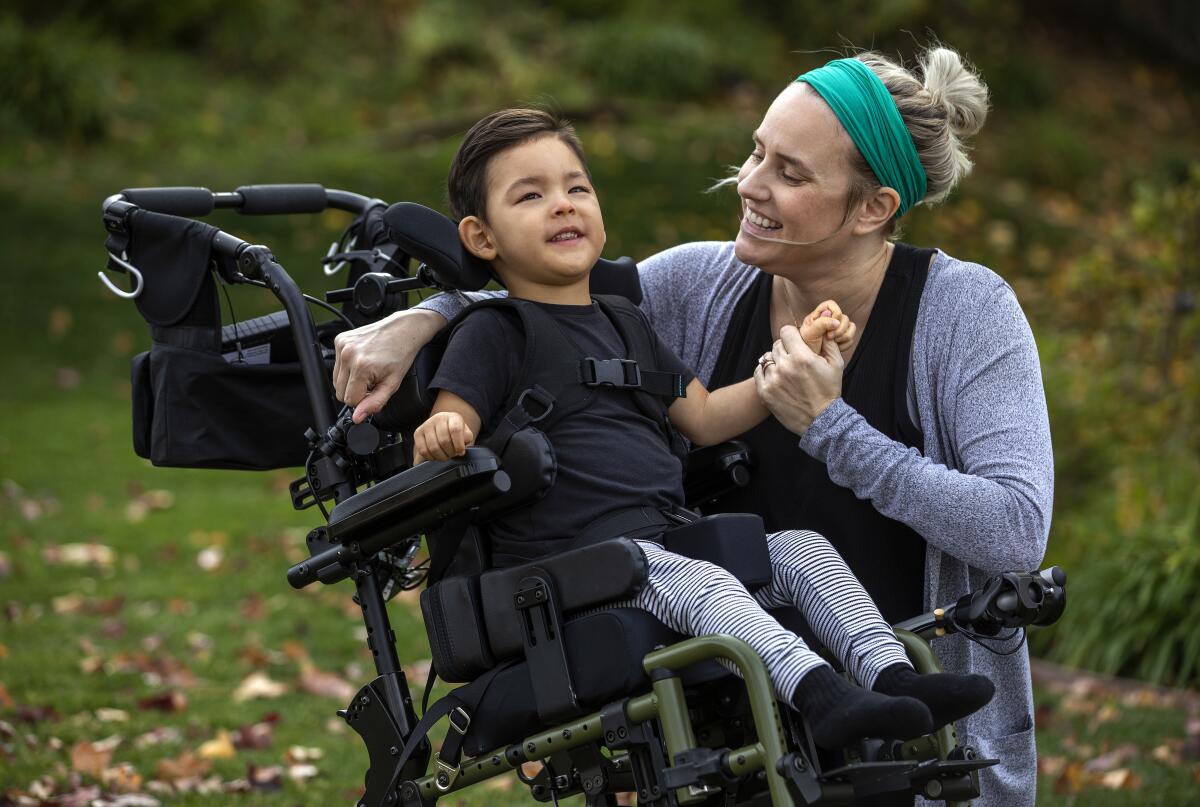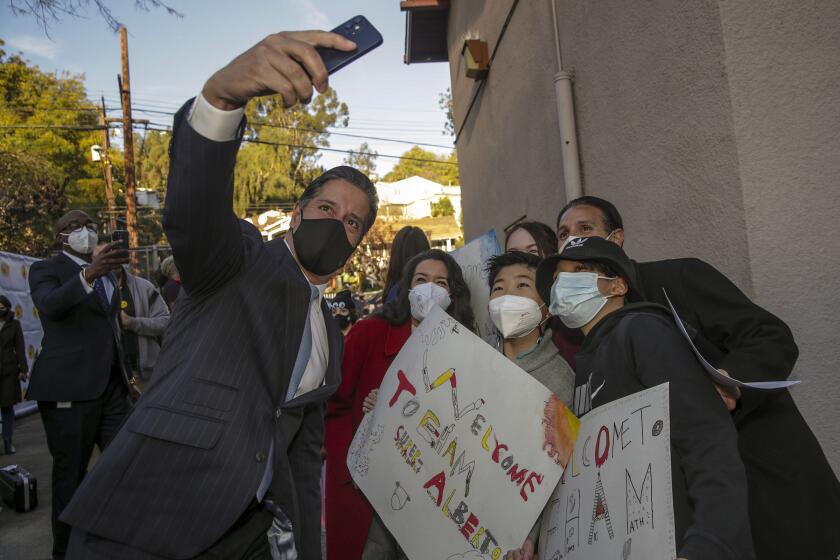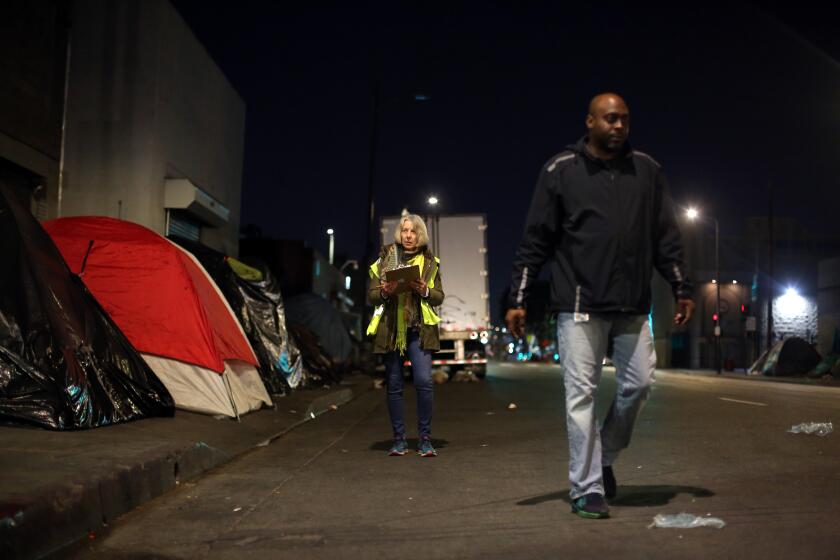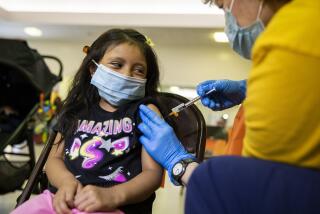More kids in the hospital with COVID renew fears for medically fragile children

- Share via
Whenever someone tells Jamie Chong that COVID-19 isn’t a serious threat to children, she reminds them that the common cold can send her child to the hospital.
Her son, Asher, who is nearing his third birthday, has cerebral palsy and issues with his respiratory and gastrointestinal systems, putting him at higher risk from the coronavirus.
Chong has been caring for him in their Simi Valley home during the pandemic and strictly limiting who can enter. Sometimes, when cases have surged, she has even decided to turn away his home nurses.
“It’s scarier than it was even in the beginning,” Chong said. “When things were really bad before, kids weren’t going to school. People were working from home. Now they’re saying it’s way more contagious — and everything is open.”
There’s the notion that “‘If you’re vulnerable, then you need to stay home.’ Well, we are doing that. But how much longer can we?” Chong asked. “My son deserves to live a life outside of his home.”
Young children — those younger than 5 — are being newly hospitalized with COVID-19 at higher rates than at any point before in the pandemic, according to federal data. Health officials say the rising numbers among children are the result of the rapid spread of the Omicron variant, which is much more easily transmitted than earlier variants of the coronavirus.
The latest surge has been especially alarming for many families with children who are medically fragile and younger than 5 — the age group still not eligible for COVID shots. Federal authorization for a vaccine for the youngest kids is still expected to be months away.
“We don’t have a vaccine. We have very few treatments available for this age group. And we’re not telling people to be judicious and careful around young children,” said Dr. Jorge A. Caballero, an anesthesiologist and co-founder of the volunteer organization Coders Against COVID.
Soaring absentee rate hits Los Angeles schools amid surging coronavirus rates.
“We can’t just ignore the needs of an entire group,” Caballero said, but “we’re largely doing the same thing with persons with disabilities of all ages.” Disability groups recently denounced remarks by the director of the Centers for Disease Control and Prevention calling it “encouraging” that disproportionate deaths occurred among people with co-morbidities.
“The public health response to COVID-19 has treated people with disabilities as disposable,” the American Assn. of People with Disabilities and scores of other groups wrote in their letter.
Young children and teens usually do not end up in the hospital from the coronavirus: Less than 1% of children and teens who have been infected have been hospitalized and 0.01% have died, according to cumulative data gathered from states by the American Academy of Pediatrics and the Children’s Hospital Assn.
But with massive surges in infections, even a small percentage of kids being hospitalized has resulted in many more children in hospital beds than before. For the seven-day period that ended Jan. 12, the U.S. was averaging 881 newly admitted children and teens with COVID-19 per day; the rate of new hospitalizations among that group is six times higher than it was two months ago.
Recent federal data show that children too young to be vaccinated were being hospitalized with COVID-19 at rates nearing those of young adults, although they were still well below the rates for middle-aged people and seniors.
At Children’s Hospital Los Angeles, there were more than 40 pediatric patients who had tested positive for the coronavirus as of early last week — nearly six times as many as in November, according to a hospital official. Roughly a quarter of children admitted with COVID-19 are heading to intensive care, and some have had to be intubated, said Dr. Michael Smit, its medical director of infection prevention and control.
“We used to have the luxury of saying, ‘It’s bad, but it’s really not that bad for most kids,’” said Dr. Garey Noritz, professor of pediatrics at Ohio State University and chairperson of the Council on Children with Disabilities for the American Academy of Pediatrics. As the numbers have surged, “it doesn’t feel like that anymore.”
The risks from COVID-19 are much more pronounced for children who are immunocompromised or medically fragile, including kids with cancer, lupus and other conditions.
As older children and adults have been able to get vaccinated, “it feels like we’ve been left behind,” said Fresno resident Matt Heidrick. “My son still isn’t vaccinated — and we need to be careful around him.”
Betsey and Matt Heidrick have kept 3-year-old Arthur in virtual preschool throughout the pandemic. Their son has spinal muscular atrophy Type 1 and uses a BiPAP machine to help him breathe at night.
He has landed in intensive care for a respiratory virus in the past. Even before COVID-19, the couple had to be careful during flu season to protect him. Whenever one of them felt ill, they would mask up and isolate themselves from the rest.
When the pandemic began, it felt like “Oh, the rest of the world is in our boat now,” Betsey Heidrick remembered. But as they approach a third year of COVID-19, she feels invisible when people suggest that the virus is no longer a threat.
Before the Omicron surge, the Heidricks would occasionally venture out with Arthur for short trips to Target when the store was not busy. A few times he has visited the zoo during quiet hours, staying outside and masked.
Now, as cases have surged, his main trips outside the home are for medical appointments. He sometimes sees other children around the neighborhood, but he is limited to waving at them from a distance, instead of joining in play.
When he can finally get vaccinated, “at least we would have some insurance that he has all the protection we can offer him,” Betsey Heidrick said. “Maybe he can play with one of the little kids. Or he can go to school. Or he can go to the zoo — and we can feel not so terrified.”
Many physicians said it remains unclear whether Omicron, which is driving up the number of cases among children, is causing illness that is any more or less severe in children than earlier variants. The new variant appears to settle higher in the respiratory tract, which can leave children vulnerable to a barking cough called croup.
Because small children have small airways, “all it takes is a little bit of swelling in those airways to cause croup,” said Dr. Graham Tse, chief medical officer at MemorialCare Miller Children’s & Women’s Hospital in Long Beach. “We’ve definitely seen increased numbers of kids that have been admitted with clinical croup” who turned out to have COVID-19.
Public health officials have also warned that children can suffer lingering effects from long COVID, which can include fatigue and breathing problems, though researchers are still assessing how often that occurs. Kids infected with the coronavirus can also get multisystem inflammatory syndrome, a rare but potentially deadly condition.
As Omicron has taken hold, “we can’t discount this as being a milder virus,” said Dr. Colleen Kraft, a general pediatrician at Children’s Hospital Los Angeles. Its sheer contagiousness means that “so many more kids are getting this and so many more kids are having to go into the hospital for this.”
Across L.A. County, there were 58 children younger than 5 who had tested positive for the coronavirus and were hospitalized as of Jan. 1. Less than a month earlier, that number was just four.
Pediatricians say that many of the same steps recommended to clamp down on COVID-19 in general — including vaccination for anyone who is eligible, masking and avoiding crowds — will help protect very young children who are medically fragile.
“There’s unquestionably value in vaccinating yourself, in terms of protecting your own health,” said Dr. Steven Barkley, chief pediatric medical officer at Cottage Children’s Medical Center in Santa Barbara.
“But the larger good is in trying to preserve our health environment for children — and for children who are in a position that they can’t be immunized and really are relying on us — adults, parents, older children — to do what we can to limit the spread of this virus,” he said.
Families are doing what they can to navigate the ongoing risks, but many decision makers across the country are not doing enough to protect young children who are medically vulnerable, including ensuring ventilation in public spaces, requiring masking and ensuring people can get tested, Caballero argued.
The Los Angeles Homeless Services Authority announced Friday that it was delaying the annual count a month citing a rising number of coronavirus cases.
“It’s very frustrating as a parent. It’s very frustrating as an advocate,” Caballero said. “We know exactly what needs to happen ... but too many decision makers and stakeholders are stuck in a mentality that children cannot get sick.”
Noritz, who practices in Ohio, argued that “if there was any sense in this, we would be in a lockdown now” as cases have surged. But Dr. Alice Kuo, director of the UCLA Center of Excellence in Maternal and Child Health, countered that lockdowns have exacerbated other issues, including child abuse and mental illness among youth.
“If all that mattered was COVID,” said Kuo, a pediatrics professor at UCLA, “then everything would be shut down again. But lockdowns aren’t sustainable, and other health concerns matter too.”
In Manhattan Beach, Devon Cordova finds herself assessing whether each person who might be around her daughter Rafaella is likely to be careful enough about COVID-19. She was reassured by the thought, before sending her daughter to see a particular teacher, that the educator had an immunocompromised relative at home.
“We can’t just say, ‘Send the kids to school, they’ll be safe.’ We have to rely on so many other people making the right choices,” Cordova said.
Rafaella has a rare disorder that affects the brain, spinal cord and immune system. She is 6 years old — old enough to get a COVID vaccine — but Cordova said her daughter has not gotten the shots because of a past reaction and medical concerns related to her condition. The rest of the family is vaccinated, said Cordova, who serves as vice president for a national organization focused on the disorder.
The pandemic pushed much of Rafaella’s therapy online, although when cases were down she began to work with her therapists outdoors. Before the Omicron surge, the family was tiptoeing back toward normal life. Rafaella had play dates in the park and had started school in person in the fall.
“And then the rug was pulled out from under us with this latest surge,” Cordova said. “I don’t really know what to do at this point. Do we go back to school?”
Noritz said of some people who have bristled at protective measures such as vaccinations and masks, “there’s a very individualistic kind of mentality around that, ‘Well, I’m going to be fine.’”
“It doesn’t protect the people who are most vulnerable,” he said.
Times staff writer Rong-Gong Lin II contributed to this report.
More to Read
Sign up for Essential California
The most important California stories and recommendations in your inbox every morning.
You may occasionally receive promotional content from the Los Angeles Times.













